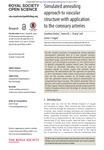Simulated annealing approach to vascular structure with application to the coronary arteries
| dc.contributor.author | Keelan, Jonathan | en_US |
| dc.contributor.author | Chung, Emma M. L. | en_US |
| dc.contributor.author | Hague, James P. | en_US |
| dc.date.accessioned | 2016-10-11T05:37:06Z | |
| dc.date.available | 2016-10-11T05:37:06Z | |
| dc.date.issued | 2016 | en_US |
| dc.identifier.other | HPU4160637 | en_US |
| dc.identifier.uri | https://lib.hpu.edu.vn/handle/123456789/23524 | en_US |
| dc.description.abstract | Department of Physical Sciences, The Open University, Milton Keynes MK7 6AA, UK 2 Department of Cardiovascular Sciences, University of Leicester, Leicester LE1 5WW, UK Do the complex processes of angiogenesis during organism development ultimately lead to a near optimal coronary vasculature in the organs of adult mammals? We examine this hypothesis using a powerful and universal method, built on physical and physiological principles, for the determination of globally energetically optimal arterial trees. The method is based on simulated annealing, and can be used to examine arteries in hollow organs with arbitrary tissue geometries. | en_US |
| dc.format.extent | 15 p. | en_US |
| dc.format.mimetype | application/pdf | en_US |
| dc.language.iso | en | en_US |
| dc.subject | Biophysics | en_US |
| dc.subject | Theoretical biology | en_US |
| dc.subject | Vascular modelling | en_US |
| dc.subject | Cardiovascular systems | en_US |
| dc.subject | Simulated annealing | en_US |
| dc.title | Simulated annealing approach to vascular structure with application to the coronary arteries | en_US |
| dc.type | Article | en_US |
| dc.size | 1.24MB | en_US |
| dc.department | Education | en_US |
Files in this item
This item appears in the following Collection(s)
-
Education [806]

